Candlewood Lake Fishing Guide
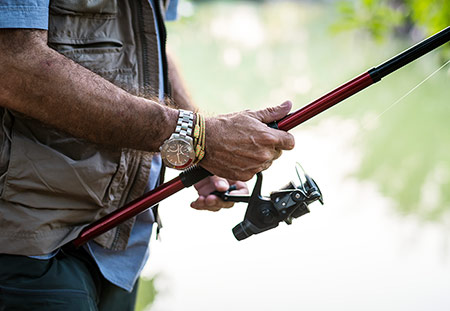 Take a day and enjoy a Candlewood Lake
fishing trip. Famous for its smallmouth bass, Candlewood Lake also contains an abundance other fish such as:
walleye, trout, crappie, perch, sunfish, catfish, chain pickerel and largemouth bass. This 5,400-acre lake
encompasses the towns of: Brookfield, Danbury, New Fairfield, New Milford, and Sherman. Candlewood Lake is 17
miles long and 2 miles wide. This manmade lake provides many, old, underwater structures that a perfect spot
for fish to hide. Many anglers consider Candlewood Lake one of the best lakes to fish in Connecticut. In 2015,
Candlewood Lake was ranked as one of the top 25 bass waters in the country by Bassmaster Magazine. There are
several public boat launches that provide access for anglers to pull up and drop their boat. In the winter
months, when the lake freezes, Candlewood Lake is the perfect spot for ice fishing. Whether you're visiting
Candlewood Lake for a guided fishing tour, dropping your boat for the day, or you're looking for a spot to
drop a line in the water, Candlewood Lake is the perfect spot for freshwater fishing!
Take a day and enjoy a Candlewood Lake
fishing trip. Famous for its smallmouth bass, Candlewood Lake also contains an abundance other fish such as:
walleye, trout, crappie, perch, sunfish, catfish, chain pickerel and largemouth bass. This 5,400-acre lake
encompasses the towns of: Brookfield, Danbury, New Fairfield, New Milford, and Sherman. Candlewood Lake is 17
miles long and 2 miles wide. This manmade lake provides many, old, underwater structures that a perfect spot
for fish to hide. Many anglers consider Candlewood Lake one of the best lakes to fish in Connecticut. In 2015,
Candlewood Lake was ranked as one of the top 25 bass waters in the country by Bassmaster Magazine. There are
several public boat launches that provide access for anglers to pull up and drop their boat. In the winter
months, when the lake freezes, Candlewood Lake is the perfect spot for ice fishing. Whether you're visiting
Candlewood Lake for a guided fishing tour, dropping your boat for the day, or you're looking for a spot to
drop a line in the water, Candlewood Lake is the perfect spot for freshwater fishing!
Below you will find a guide to Candlewood Lake fishing. Browse the different kinds of fish to catch on the lake. Watch some of the fishing videos we have collected to catch some Candlewood Lake fishing secrets. Looking for fishing related services on Candlewood? We for you covered! We have compiled a list of fishing guides, bait shops, and boat launches. Don't see your business listed? Drop us a line!
Fish in Candlewood Lake
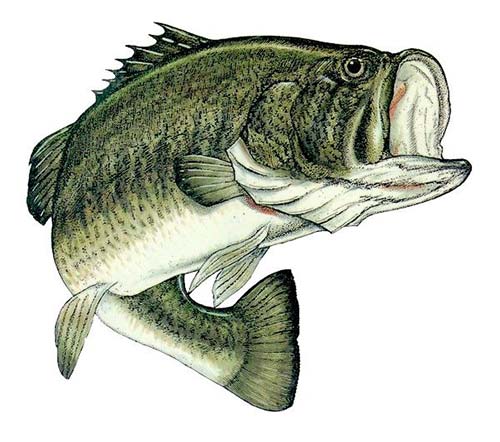
Largemouth Bass
Micropterus salmoides
Largemouth Bass are the most popular gamefish in the United States and are found in every state except Alaska. They are the subject of countless fishing shows, magazine articles, books, etc. Largemouth Bass are an aggressive fish that can be targeted using a huge variety of techniques, so no matter what kind of fishing you like to do you can probably catch a bass with it. Bass are ambush feeders that pounce on prey that comes by them. Even when they are not feeding, they will often pounce on lures out of sheer aggressiveness. Largemouth Bass prefer slightly stained to murky water with cover and minimal current, in depths from one foot to sixty feet. Ideal water temperature for activity is 60 to 80 degrees. Largemouth Bass can attain weights of over 20lbs but very, very few fish get anywhere near that size. Any bass over 6lbs is generally a female. The average bass caught is probably only around 2lbs.
Tackle to Use
Largemouth Bass will literally strike at anything that fits into their mouth.
Most largemouth bass can be caught with: spinnerbaits, crankbaits, jerkbaits, top water lures, jigs, rubber
worms, and shiners.
CT Record: 12lbs 14oz
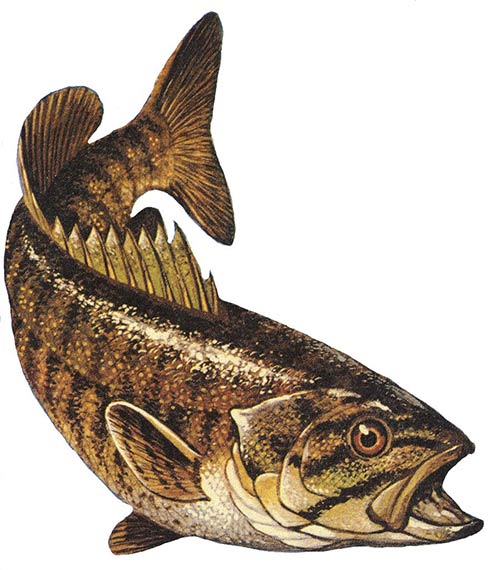
Smallmouth Bass
Micropterus dolomieu
Smallmouth Bass tend to frequent colder waters than the largemouth although in many places the same lake will hold both species. Smallmouth also tend to spawn and generally hang out in deeper water. Smallmouth Bass prefer rocky areas of clear to slightly stained water in depths from one foot to fifty feet, with or without current. Ideal water temperature for activity is 58-72 degrees. Smallmouth bass do not attain the same large potential size as the Largemouth. A 5-lb smallmouth is a very big one and they top out around twice that. Smallmouth Bass may be small in size, but they are famous for the fight they put up when on the line.
Tackle to Use
In cold water, small baits worked very slowly are often the only way to provoke a
strike. In warm water they can feed quite aggressively and will readily take crankbaits, spinnerbaits,
topwater lures, jigs, worms and most baits that resemble baitfish or crawfish.
CT Record: 7 lbs 12 oz
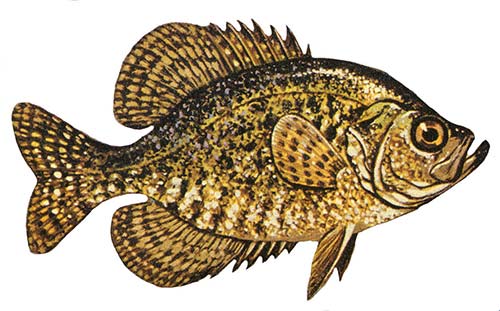
Black Crappie
Promoxis nigro-maculatus
Also known as specks, calico bass, papermouths, sac-a-lait, and speckled perch, crappie are generally considered the most desirable panfish. This is likely due to their striking body color patterning and the fact that they taste good. They can be ridiculously easy to catch when you find them during some parts of the year, particularly in the spring. Crappie have very soft, thin mouths so you can't pull on them too hard or you will pull the hook out. Crappie prefer warmer, slightly stained to murky water with little or no current with brush or trees for cover. Ideal water temperature for crappies is 64-80 degrees. Both the black and white crappie can grow to over five pounds while three quarters of a pound to a pound is more typical.
Tackle to Use
Baits which imitate minnows, insects, worms or small crustaceans will attract
crappie. The more aggressive the crappie are, the faster you can move the bait to cover more water. Spring is
the best time to catch crappie as they are involved in their spawning runs.

Walleye
Sander Vitreus
Walleye are a member of the perch family. They have a long, slender body with a spiny dorsal fin. Walleyes achieve a larger maximum size and can be identified by the white spot on the lower half of their tails. Walleyes average around 14-22" and 2-4 lbs in most lakes, but can achieve much larger sizes. Walleye prefer slightly stained to murky water with little or no current. The ideal water temperature for walleye is 38-60 degrees. Walleye is a favorite of the white meat, fresh water fishes. Candlewood has very few Walleye, most of the ones in the lake snuck in from Squantz Pond.
Tackle to Use
Fish for walleye with live bait, spinners, spoons, crankbaits, jerkbaits, small
spinner baits as well as plastic worms and grubs. Trolling is a very effective way to fish for these tasty
fish. Walleye can be found on shallow bars or shoals with clean bottom surfaces near deep water.
CT Record: 14lbs 8oz on Candlewood!

Rainbow Trout
Oncorhynchus mykiss
Candlewood Lake is a Trout Management Lake and is actively stocked with trout and many other fish. Rainbow trout are probably the most common and easiest to catch of all trout. Even the stocked fish, however, can often be picky and sometimes you have to try a variety of approaches before you find what they want that day. Most rainbow trout caught range from 1/2 to 3lbs in size, with anything much over that being a pretty decent fish. Rainbow Trout Prefers slightly stained to clear water with or without current. The ideal water temperature for rainbow trout is 45-60 degrees. They feed on small insects, minnows, crustaceans and worms. Rainbow trout fishing is fun for both sport and dining pleasures.
Tackle to Use
Rainbow trout eat a number of different types of lures, including spinners,
spoons, plugs, and jigs in the 1"-3" size range. Trout have good eyesight and will often be scared away by
line that is too visible, so make sure to use low visibility line.
CT Record: 14lbs 10oz
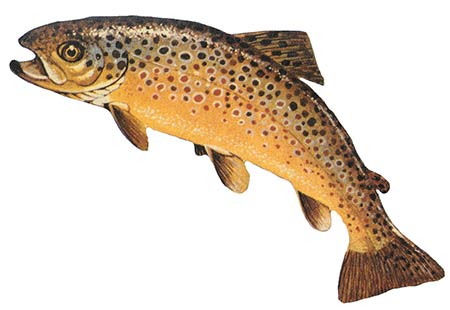
Brown Trout
Salmo trutta
Brown Trout are less plentiful and tougher to catch than their cousins the rainbow trout. Many of the same techniques that work for rainbows will work for browns. They often live in the same places and eat the same things. Browns can exceed 40lbs but fish anywhere near that size are extremely rare. Anything over 4lbs is a nice fish. brown trout look for quiet water with lots of cover. Logs, under cuts in the bank, rock shelves, overhanging trees and brush are some of the brown trouts favorite hiding places. Brown trout prefer clear to slightly stained water with little or no current. Ideal water temperature is 45-62 degrees.
Tackle to Use
Brown trout feed on worms, minnows, insects and crustaceans. Dry fly fishing for
pan-sized browns is a favorite technique as they rise well to these crafty presentations. Larger browns tend
to feed more on flesh and favor nutritious crustaceans, worms or small fishes.
CT Record: 19lbs

Bluegill
Lepomis macrochirus
These feisty panfish are found throughout the country in bodies of water big and small. In some areas, especially during their spawning season, the males are strikingly colored with bright blue, purple, and orange. They often come up shallow, especially in the spring and summer, and can be observed from shore if the water is clear enough. Bluegill prefer slightly stained to murky water with little or no current. The ideal water temperature for bluegill is 60-85 degrees. A one pound Bluegill is pretty decent fish, anything over 2 pounds is a trophy fish! They are a great fish to get kids hooked on fishing.
Tackle to Use
Bluegill are most easily caught on bait but will often bite lures as well. They
are a curious fish and will put things in their mouth just to check them out. You just need to make sure you
are using a small enough hook to fit in their little mouths.
CT Record: 2lbs 4oz
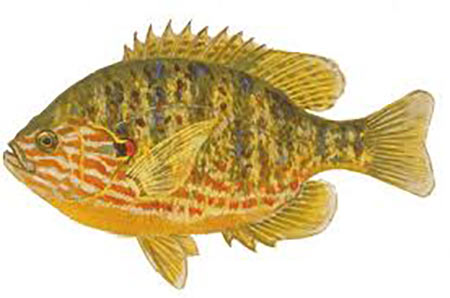
Pumpkin Seed
Lepomis gibbosus
Shaped like a pumpkin seed and often has body coloring similar to a pumpkin color, their favorite habitat is weed-covered lake bottoms in clear water. They prefer warmer water temperatures from mid seventies to low eighties.
Tackle to Use
Fish for them on light tackle with small hooks using worms, insects, prepared
bait and cut bait.
CT Record: 1lb 3oz
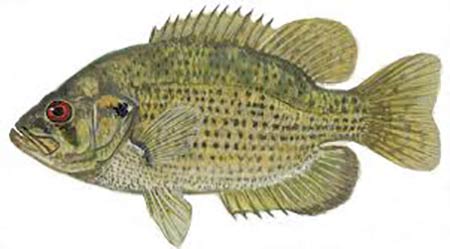
Rock Bass
Ambloplites rupestris
The rock bass is good eating and fun to catch on light tackle or a fly rod. They feed primarily on smaller fish, insects, and crustaceans. Rock bass make their home in clear water, preferring rocky bottoms with vegetation. The ideal water temperature for rock bass is 64-72 degrees.
Tackle to Use
Worms, grubs and cut bait work well.
CT Record: 1lb 3oz
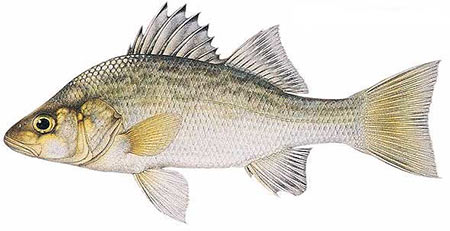
White Perch
Morone americana
The white perch is named for its color which is generally white or silver with shades of adaptive color from its environment to help it hide from predators. They are quite prolific and can be considered a nuisance in some waters. White perch make a great fish fry with nice filets coming from ones approaching a pound. Ideal water temperature for white perch is 62-70 degrees.
Tackle to Use
Use light tackle to fish for white perch. For bait, use worms, minnows, jigs,
spoons and very small lures imitating baitfish.
CT Record: 3lbs 1oz
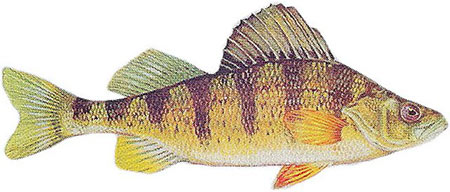
Yellow Perch
Perca flavescens
Yellow perch are generally yellow, to gold, to brown in color and most often lighter shades of these colors. Dark vertical bands decorate their sides. They average about a third of a pound and 6 inches long, many larger ones are often caught as well. Their primary diet consists of minnows and other small fish, insects and worms. Yellow perch prefer water temperatures from 66 to 70 degrees but remain active in temperatures outside this range.
Tackle to Use
Use worms, minnows, small jigs. spinners or cut bait
CT Record: 2lbs 13oz

Chain Pickeral
Esox niger
A freshwater fish in the pike family easily identified by the "chain-like" marking along its sides. Its primary food source is smaller fish and is known to lie in wait to ambush its prey. While it can be eaten it is not considered one of the better sport fishes for table fare. Ideal water temperature is 62-70 degrees. Chain Pickeral are very elusive on Candlewood.
Tackle to Use
Chain pickerel can be caught on fish-imitation lures and live or cut bait. Watch
the sharp teeth when handling.
CT Record: 8lbs 9oz
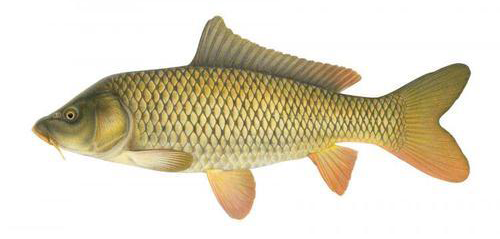
Carp
Cyprinus carpio
The common carp is a heavy-bodied minnow with barbels on either side of the upper jaw. Typically, color varies from brassy green or yellow, to golden brown, or even silvery.
Tackle to Use
Believe it or not the best bait to use for carp is fake corn/maize or bread!
CT Record: 43lbs 12oz
Candlewood Lake Fishing Videos
Paul Mueller, Bassmaster Elite Pro, catching various fish on Candlewood Lake
Paul Mueller Shows you how to catch Smallmouth bass with swimbaits in cold water.
To have Paul guide you on Candlewood Lake visit his website at www.paulmuellerfishing.com
In this video, Derek Handberry hooks into some of the largest freshwater fish that Connecticut has to offer. Watch this video until the end to see us catch massive Candlewood lake fish on very light line.
Ice fishing on Candlewood Lake in Danbury with ResDogFishing
Pro Tips
We want you to catch fish! We are currently polling professional anglers on the lake to get you the secrets to reeling in the big one. Check back frequently to see new tips! Contact us to have your tip posted here.
"There really is no cheat code for Candlewood. It's either feast or famine and it's very
spotty. You can go out in a tournament and catch nothing all day and another guy will come in with 20 pounds.
The best advice I can give to an experienced angler is to put their time in and learn a few good spots in each
town. If the bite is off in one town keep moving until you find the fish. If your not an experienced angler
try using live alewives. The video below should be helpful ."
- Derek Handberry
Local Fishing Resources!
Here are some local businesses that cater to Candlewood Lake Fishermen. To have your business listed, Contact Us!
Paul Mueller Fishing
www.paulmuellerfishing.com
203-910-3676
Candlewood Bait & Tackle
www.candlewoodbait.com
36 Tamarack Ave, Ste. 5, Danbury
203-743-2221
Be sure to check out the Candlewood Lake FAQ to learn everything there is to know about the lake!